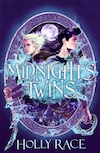When I'm not slaving over first drafts or edits, I can usually be found either watching TV or films, or reading scripts. About ten years ago I started working in film and TV development. Development encompasses a variety of jobs, but it’s essentially about finding new ideas and new writers, and working with writers from the inception of an idea right through pitching it to broadcasters or investors, then being a sounding board and editor when they’re writing the script.
In this other life as a script editor, I spend a lot of time thinking about how much crossover there is between the skills of writing novels and writing scripts (if I externalised my scream anytime someone says 'Oh, writing scripts is just about writing dialogue', I would have lost my voice by now).
One of the elements I think we can learn from as novel-writers is the way in which directors and cinematographers use camera angles. Here are a handful of angles commonly used on screen:
 |
| Close up! |
- Close up & extreme close up – these give us a level of detail into a scene or a character’s expression.
- Montage – this is a sequence of shots that are usually made cohesive by music or a voiceover, and they can be used to give an impression of time passing or to show us what's happening at the same time in multiple settings.
 |
| Quick cuts |
 |
| Zooming in |
- Zoom in/ out – This is the smooth transition from a longer shot to a close-up or vice versa. Depending on how quickly you do it, you can create different effects. In this classic shot from Jaws, we get a very fast zoom, which visualises the character’s sudden panic and realisation.
- Long shot (below) is fairly self-explanatory – it gives you an impression of a vast landscape and is used a lot in fantasy.
 |
| Long shot |
 |
| From below |
- Point of view shot is where the audience sees ‘through’ a character’s eyes. It’s the most literal equivalent to a first-person present voice.
- Pan across/ up/ down – this is a great shot for injecting a feeling of movement and momentum. It can be used as a transition – sometimes you pan the camera up to the sky and when you pan it down the scenery has changed a little to denote the passing of time, for example. Sometimes it’s simply used to follow someone as they move.
As novelists, we have complete control of what we can show to our readers, and there can be a temptation to get a bit lost in describing everything that we see in our head. If you’ve spent a lot of time working out exactly where your characters are standing, exactly what movements they’re making at any given moment or the full layout of the room they’re in, it’s easy to want to convey all of that to your reader in minute detail. But it’s not necessarily serving the story.
Watch any scene from your favourite film or TV show, and note how sparing and deliberate the camera angles are in most of them. Can you imagine how those scenes would come across if the director panned right the way around the space, picking out absolutely every object the art department had put in there? If they had done close-up shots of every character’s blink or cough or hand movement? What do you think that would do to the momentum and pace? Would it make the story clearer? Would it give us any more insight into the characters? I think we can all agree that the answer is: no! It would be confusing and disorientating.
We can apply similar methods to our prose writing. Think very carefully about what you need to convey for the purposes of your story. To have a level of detail in your head about how a scene looks is great, but you don’t need to put all of that down on the page. As writers, we are the camera, and where we place it can make all the difference to the readers' enjoyment and comprehension of our stories.
---
Holly Race worked for many years as a script editor in film and television, before becoming a writer.
Her YA urban fantasies, Midnight's Twins and A Gathering Midnight, are published by Hot Key Books.




1 comment:
Thank you.
Some years ago I explored the intersection of everyday writing with screen writing.
It turned out like this...( from 2006 ).
" Janet Street-Porter ....
Looks like I've got to correct something.
On one of my earlier posts, I suggested that perhaps the reason
for Janet Street-Porter's 6 marriages was her moaning.
Apparently this is not true, at least according to the more recent
article in one of the Sunday's. According to Janet, within quite
a short time of marrying her first husband Tim Street-Porter, she
was off sleeping with various people. She didn't feel anything for
them, it was just good sex, and she didn't give the matter(s) much
of a second thought. And she didn't feel that she was doing
anything objectionable.
However, she wrote, when Tim found out he seemed to get terribly
upset, and promply left her. And she felt that she had ruined a
perfectly good marriage.
...... 3am. Front door opens. Figure enters hallway. Climbs stairs.
[Camera follows]. No knickers. Bitemarks on bum. "I'm home, dear.."
....".
Post a Comment